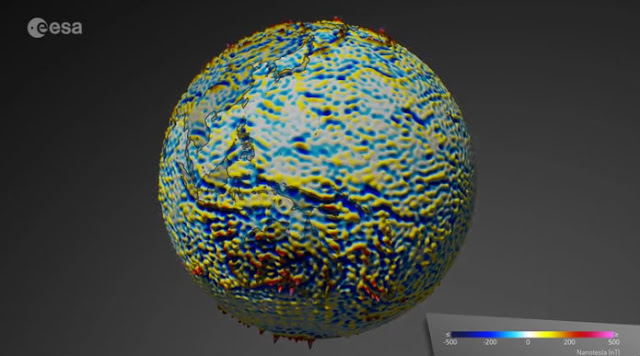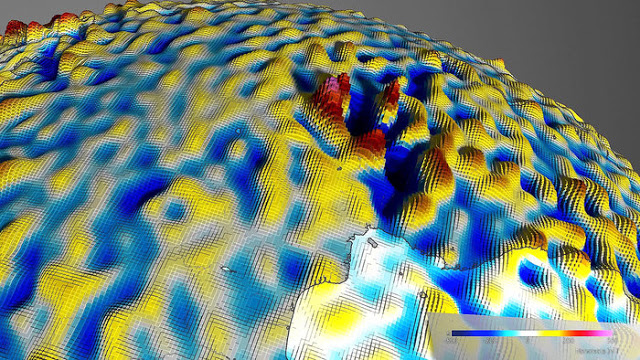

| Online: | |
| Visits: | |
| Stories: |

| Story Views | |
| Now: | |
| Last Hour: | |
| Last 24 Hours: | |
| Total: | |
Upper Part of Earth’s Magnetic Field Reveals a Dramatic Past
“By combining Swarm measurements with historical data from the German CHAMP satellite, and using a new modelling technique, it was possible to extract the tiny magnetic signals of crustal magnetization with unprecedented accuracy,” said professor Nils Olsen from the Technical University of Denmark (DTU), one of the team of scientists behind the new map that has just been released at a Swarm Science Meeting in Banff, Canada.
Most of the Earth magnetic field is generated at depths greater than 3000 km by the movement of molten iron in the outer core. The remaining 6 percent – including the ‘lithospheric magnetic field’ – is partly due to electrical currents in space surrounding Earth, and partly due to magnetised rocks in the upper lithosphere – the rigid outer part of Earth, consisting of the crust and upper mantle.
Magnetic field model/Magnetic anomaly
Swarm is a constellation of three identical satellites launched by the European Space Agency (ESA) to track and study the Earth’s magnetic field.
Possible meteorite impact
The new map shows detailed variations in this field caused by geological structures in Earth’s crust. One of these anomalies occurs in Central African Republic, centred around the city of Bangui, where the magnetic field is significantly sharper and stronger. The cause for this anomaly is still unknown, but scientists speculate that it may be the result of a meteorite impact there some 540 million years ago.
Evidence of flipping poles
The new map also reveals more details about the Earth’s magnetic field that has flipped its polarity many times over the millennia. The magnetic field is in a permanent state of flux. Magnetic north wanders, and every few hundred thousand years the polarity flips so that a compass would point south instead of north.
Credit: European Space Agency, ESA
Since magnetic poles flip back and forth over time, the solidified minerals form ‘stripes’ on the seafloor and provide a record of Earth’s magnetic history.
Latest map of the lithospheric magnetic field by Swarm shows detailed variations in this field more precisely than previous satellite-based reconstructions, caused by geological structures in Earth’s crust. One of these anomalies occurs in Central African Republic, centred on the city of Bangui, where the magnetic field is significantly sharper and stronger. The cause for this anomaly is still unknown, but some scientists speculate that it may be the result of a meteorite impact more than 540 million years ago.
Credit: ESA
“These magnetic stripes are evidence of pole reversals and analysing the magnetic imprints of the ocean floor allows the reconstruction of past core field changes. They also help to investigate tectonic plate motions,” said Dhananjay Ravat from the University of Kentucky in the USA.
“The new map defines magnetic field features down to about 250 km and will help investigate geology and temperatures in Earth’s lithosphere.”
ESA’s Swarm mission manager, Rune Floberghagen, added:
“Understanding the crust of our home planet is no easy feat. Measurements from space have great value as they offer a sharp global view on the magnetic structure of our planet’s rigid outer shell.”
Earth’s magnetic field can be thought of as a huge cocoon, protecting us from cosmic radiation and charged particles that bombard our planet in solar wind. Without it, life as we know it would not exist.
Contacts and sources:
Nils Olsen, Professor -head of Geomagnetism, DTU Space
Technical University of Denmark (DTU)
Source: http://www.ineffableisland.com/2017/03/upper-part-of-earths-magnetic-field.html




